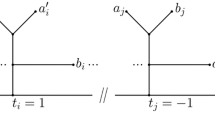Abstract.
Sequence data for a group of species is often summarized by a distance matrix M where M[s,t] is the dissimilarity between the sequences of species s and t . An ordinal assertion is a statement of the form ``species a and b are as similar as species c and d '' and is supported by distance matrix M if M[a,b] ≤ M[c,d] . Recent preliminary research suggests that ordinal assertions can be used to reconstruct the evolutionary history of a group of species effectively. However, further research on the mathematical and algorithmic properties of ordinal assertions is needed to facilitate the development and assessment of inference methods that utilize ordinal assertions for reconstructing evolutionary histories.
A (weighted ) ordinal representation of a distance matrix M is a (weighted) phylogeny T such that, for all species a , b , c , and d labeling T ,
d T (a,b) ≤ d T (c,d) if and only if M[a,b] ≤ M[c,d],
where d T is the weighted path length when T is weighted, otherwise d T is the unweighted path length. Hence, an ordinal representation of M is a phylogeny that supports the same ordinal assertions supported by M , and so is the focus of our examination of the mathematical and algorithmic properties of ordinal assertions.
As it turns out, ordinal representations are rich in structure. In this paper several results on weighted and unweighted ordinal representations are presented:
— The unweighted ordinal representation of a distance matrix is unique. This generalizes the well-known result that no two phylogenies share the same distance matrix [10], [21].
— The unweighted ordinal representation of a distance matrix can be found in O(n 2 log 2 (n)) time. The algorithm presented improves upon an O(n 3 ) algorithm by Kannan and Warnow [13] that finds binary unweighted ordinal representations of distance matrices.
— Under certain conditions, weighted ordinal representations can be found in polynomial time.
Similar content being viewed by others
Author information
Authors and Affiliations
Additional information
Received May 11, 1997; revised March 13, 1998.
Rights and permissions
About this article
Cite this article
Kearney, P., Hayward, R. & Meijer, H. Evolutionary Trees and Ordinal Assertions. Algorithmica 25, 196–221 (1999). https://doi.org/10.1007/PL00008274
Issue Date:
DOI: https://doi.org/10.1007/PL00008274




